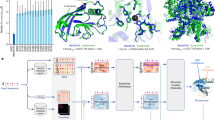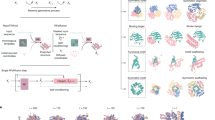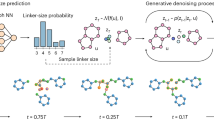Abstract
Protein function often depends on the exchange between conformational substates. Allosteric ligand binding or distal mutations can stabilize specific active-site conformations and consequently alter protein function. Observing alternative conformations at low levels of electron density, in addition to comparison of independently determined X-ray crystal structures, can provide mechanistic insights into conformational dynamics. Here we report a new algorithm, CONTACT, that identifies contact networks of conformationally heterogeneous residues directly from high-resolution X-ray crystallography data. Contact networks determined for Escherichia coli dihydrofolate reductase (ecDHFR) predict the observed long-range pattern of NMR chemical shift perturbations of an allosteric mutation. A comparison of contact networks in wild-type and mutant ecDHFR suggests that mutations that alter optimized contact networks of coordinated motions can impair catalytic function. CONTACT-guided mutagenesis can exploit the structure-dynamics-function relationship in protein engineering and design.
This is a preview of subscription content, access via your institution
Access options
Subscribe to this journal
Receive 12 print issues and online access
$259.00 per year
only $21.58 per issue
Buy this article
- Purchase on Springer Link
- Instant access to full article PDF
Prices may be subject to local taxes which are calculated during checkout





Similar content being viewed by others
References
Fraser, J.S. & Jackson, C.J. Mining electron density for functionally relevant protein polysterism in crystal structures. Cell. Mol. Life Sci. 68, 1829–1841 (2011).
Karplus, M. & Kuriyan, J. Molecular dynamics and protein function. Proc. Natl. Acad. Sci. USA 102, 6679–6685 (2005).
Marlow, M.S., Dogan, J., Frederick, K.K., Valentine, K.G. & Wand, A.J. The role of conformational entropy in molecular recognition by calmodulin. Nat. Chem. Biol. 6, 352–358 (2010).
Fraser, J.S. et al. Hidden alternative structures of proline isomerase essential for catalysis. Nature 462, 669–673 (2009).
Yu, B. et al. Structural and energetic mechanisms of cooperative autoinhibition and activation of Vav1. Cell 140, 246–256 (2010).
Fraser, J.S. et al. Accessing protein conformational ensembles using room-temperature X-ray crystallography. Proc. Natl. Acad. Sci. USA 108, 16247–16252 (2011).
Whitten, S.T., García-Moreno, E.B. & Hilser, V.J. Local conformational fluctuations can modulate the coupling between proton binding and global structural transitions in proteins. Proc. Natl. Acad. Sci. USA 102, 4282–4287 (2005).
Mittermaier, A.K. & Kay, L.E. Observing biological dynamics at atomic resolution using NMR. Trends Biochem. Sci. 34, 601–611 (2009).
Goodey, N.M. & Benkovic, S.J. Allosteric regulation and catalysis emerge via a common route. Nat. Chem. Biol. 4, 474–482 (2008).
Kern, D. & Zuiderweg, E.R. The role of dynamics in allosteric regulation. Curr. Opin. Struct. Biol. 13, 748–757 (2003).
Burling, F. & Brünger, A. Thermal motion and conformational disorder in protein crystal structures: comparison of multi-conformer and time-averaging models. Isr. J. Chem. 34, 165–175 (1994).
Levin, E.J., Kondrashov, D.A., Wesenberg, G.E. & Phillips, G.N. Jr. Ensemble refinement of protein crystal structures. Structure 15, 1040–1052 (2007).
Knight, J.L. et al. Exploring structural variability in X-ray crystallographic models using protein local optimization by torsion-angle sampling. Acta Crystallogr. D Biol. Crystallogr. 64, 383–396 (2008).
Kuriyan, J. et al. Exploration of disorder in protein structures by X-ray restrained molecular dynamics. Proteins 10, 340–358 (1991).
Terwilliger, T.C. et al. Interpretation of ensembles created by multiple iterative rebuilding of macromolecular models. Acta Crystallogr. D Biol. Crystallogr. 63, 597–610 (2007).
Wilson, M.A. & Brunger, A.T. The 1.0 Å crystal structure of Ca2+-bound calmodulin: an analysis of disorder and implications for functionally relevant plasticity. J. Mol. Biol. 301, 1237–1256 (2000).
Rader, S.D. & Agard, D.A. Conformational substates in enzyme mechanism: the 120K structure of α-lytic protease at 1.5 Å resolution. Protein Sci. 6, 1375–1386 (1997).
Burnley, B.T., Afonine, P.V., Adams, P.D. & Gros, P. Modelling dynamics in protein crystal structures by ensemble refinement. eLife 1, e00311 (2012).
van den Bedem, H., Dhanik, A., Latombe, J.-C. & Deacon, A.M. Modeling discrete heterogeneity in X-ray diffraction data by fitting multi-conformers. Acta Crystallogr. D Biol. Crystallogr. 65, 1107–1117 (2009).
Lang, P.T. et al. Automated electron-density sampling reveals widespread conformational polymorphism in proteins. Protein Sci. 19, 1420–1431 (2010).
Lindorff-Larsen, K., Best, R.B., Depristo, M.A., Dobson, C.M. & Vendruscolo, M. Simultaneous determination of protein structure and dynamics. Nature 433, 128–132 (2005).
Serrano, P. et al. Comparison of NMR and crystal structures highlights conformational isomerism in protein active sites. Acta Crystallogr. Sect. F Struct. Biol. Cryst. Commun. 66, 1393–1405 (2010).
Young, M.A., Gonfloni, S., Superti-Furga, G., Roux, B. & Kuriyan, J. Dynamic coupling between the SH2 and SH3 domains of c-Src and Hck underlies their inactivation by C-terminal tyrosine phosphorylation. Cell 105, 115–126 (2001).
Halabi, N., Rivoire, O., Leibler, S. & Ranganathan, R. Protein sectors: evolutionary units of three-dimensional structure. Cell 138, 774–786 (2009).
McClendon, C.L., Friedland, G., Mobley, D.L., Amirkhani, H. & Jacobson, M.P. Quantifying correlations between allosteric sites in thermodynamic ensembles. J. Chem. Theory Comput. 5, 2486–2502 (2009).
DuBay, K.H., Bothma, J.P. & Geissler, P.L. Long-range intra-protein communication can be transmitted by correlated side-chain fluctuations alone. PLoS Comput. Biol. 7, e1002168 (2011).
Kidd, B.A., Baker, D. & Thomas, W.E. Computation of conformational coupling in allosteric proteins. PLoS Comput. Biol. 5, e1000484 (2009).
Eisenmesser, E.Z. et al. Intrinsic dynamics of an enzyme underlies catalysis. Nature 438, 117–121 (2005).
Schlegel, J., Armstrong, G.S., Redzic, J.S., Zhang, F. & Eisenmesser, E.Z. Characterizing and controlling the inherent dynamics of cyclophilin-A. Protein Sci. 18, 811–824 (2009).
Boehr, D.D., McElheny, D., Dyson, H.J. & Wright, P.E. The dynamic energy landscape of dihydrofolate reductase catalysis. Science 313, 1638–1642 (2006).
Sawaya, M.R. & Kraut, J. Loop and subdomain movements in the mechanism of Escherichia coli dihydrofolate reductase: crystallographic evidence. Biochemistry 36, 586–603 (1997).
Boehr, D.D. et al. A distal mutation perturbs dynamic amino acid networks in dihydrofolate reductase. Biochemistry 52, 4605–4619 (2013).
Cameron, C.E. & Benkovic, S.J. Evidence for a functional role of the dynamics of glycine-121 of Escherichia coli dihydrofolate reductase obtained from kinetic analysis of a site-directed mutant. Biochemistry 36, 15792–15800 (1997).
Rod, T.H., Radkiewicz, J.L. & Brooks, C.L. Correlated motion and the effect of distal mutations in dihydrofolate reductase. Proc. Natl. Acad. Sci. USA 100, 6980–6985 (2003).
Mauldin, R.V., Sapienza, P.J., Petit, C.M. & Lee, A.L. Structure and dynamics of the G121V dihydrofolate reductase mutant: lessons from a transition-state inhibitor complex. PLoS ONE 7, e33252 (2012).
Bhabha, G. et al. A dynamic knockout reveals that conformational fluctuations influence the chemical step of enzyme catalysis. Science 332, 234–238 (2011).
Boutet, S. et al. High-resolution protein structure determination by serial femtosecond crystallography. Science 337, 362–364 (2012).
Halle, B. Biomolecular cryocrystallography: structural changes during flash-cooling. Proc. Natl. Acad. Sci. USA 101, 4793–4798 (2004).
Zhuravlev, P.I. & Papoian, G.A. Protein functional landscapes, dynamics, allostery: a tortuous path towards a universal theoretical framework. Q. Rev. Biophys. 43, 295–332 (2010).
Khersonsky, O. et al. Optimization of the in-silico-designed kemp eliminase KE70 by computational design and directed evolution. J. Mol. Biol. 407, 391–412 (2011).
Brünger, A.T. Free R value: a novel statistical quantity for assessing the accuracy of crystal structures. Nature 355, 472–475 (1992).
Dror, R.O., Dirks, R.M., Grossman, J.P., Xu, H. & Shaw, D.E. Biomolecular simulation: a computational microscope for molecular biology. Annu. Rev. Biophys. 41, 429–452 (2012).
Adams, P.D. et al. PHENIX: a comprehensive Python-based system for macromolecular structure solution. Acta Crystallogr. D Biol. Crystallogr. 66, 213–221 (2010).
Osborne, M.J., Schnell, J., Benkovic, S.J., Dyson, H.J. & Wright, P.E. Backbone dynamics in dihydrofolate reductase complexes: role of loop flexibility in the catalytic mechanism. Biochemistry 40, 9846–9859 (2001).
Falzone, C.J. et al. 1H, 15N and 13C resonance assignments, secondary structure, and the conformation of substrate in the binary folate complex of Escherichia coli dihydrofolate reductase. J. Biomol. NMR 4, 349–366 (1994).
Winter, G., Lobley, C.M.C. & Prince, S.M. Decision making in xia2. Acta Crystallogr. D Biol. Crystallogr. 69, 1260–1273 (2013).
Kabsch, W. XDS. Acta Crystallogr. D Biol. Crystallogr. 66, 125–132 (2010).
McCoy, A.J. et al. Phaser crystallographic software. J. Appl. Crystallogr. 40, 658–674 (2007).
Acknowledgements
H.v.d.B. is supported by the US National Institute of General Medical Sciences Protein Structure Initiative (U54GM094586) at the Joint Center for Structural Genomics and SLAC National Accelerator Laboratory LDRD (Laboratory Directed Research and Development) grant SLAC-LDRD-0014-13-2; G.B. is supported as a Merck Fellow of the Damon Runyon Cancer Research Foundation (DRG-2136-12); K.Y. is supported by the General Wang Yaowu Stanford graduate fellowship; P.E.W. is supported by the US National Institutes of Health (GM75995); J.S.F. is supported by the US National Institutes of Health Early Independence Award (DP5OD009180). We acknowledge T. Alber, T. Kortemme, D. Keedy, D. Kern, D. Tawfik and R. Woldeyes for helpful discussions; N. Echols for advice on different treatments of hydrogen atoms in Phenix; J. Holton, J. Tanamachi and G. Meigs at Advanced Light Source Beamline 8.3.1 for support with X-ray data collection; B. Duggan and D. Boehr for chemical shift data on G121V ecDHFR complexes; and H. Axelrod and C. Trame for data collection and refinement of RT RBM39.
Author information
Authors and Affiliations
Contributions
H.v.d.B., G.B., P.E.W. and J.S.F. designed and performed experiments, analyzed data and prepared the manuscript; G.B. and J.S.F. collected data; and H.v.d.B., K.Y. and J.S.F. developed analytical tools.
Corresponding authors
Ethics declarations
Competing interests
The authors declare no competing financial interests.
Supplementary information
Supplementary Text and Figures
Supplementary Figures 1–7, Supplementary Tables 1–4 and Supplementary Note (PDF 6570 kb)
Supplementary Software
CONTACT (ZIP 481 kb)
Rights and permissions
About this article
Cite this article
van den Bedem, H., Bhabha, G., Yang, K. et al. Automated identification of functional dynamic contact networks from X-ray crystallography. Nat Methods 10, 896–902 (2013). https://doi.org/10.1038/nmeth.2592
Received:
Accepted:
Published:
Issue Date:
DOI: https://doi.org/10.1038/nmeth.2592
This article is cited by
-
A Minireview on Temperature Dependent Protein Conformational Sampling
The Protein Journal (2021)
-
Temperature-jump solution X-ray scattering reveals distinct motions in a dynamic enzyme
Nature Chemistry (2019)
-
Enzyme activity and structural features of three single-domain phloem cyclophilins from Brassica napus
Scientific Reports (2019)
-
Rescue of conformational dynamics in enzyme catalysis by directed evolution
Nature Communications (2018)
-
De novo design of a hyperstable non-natural protein–ligand complex with sub-Å accuracy
Nature Chemistry (2017)



